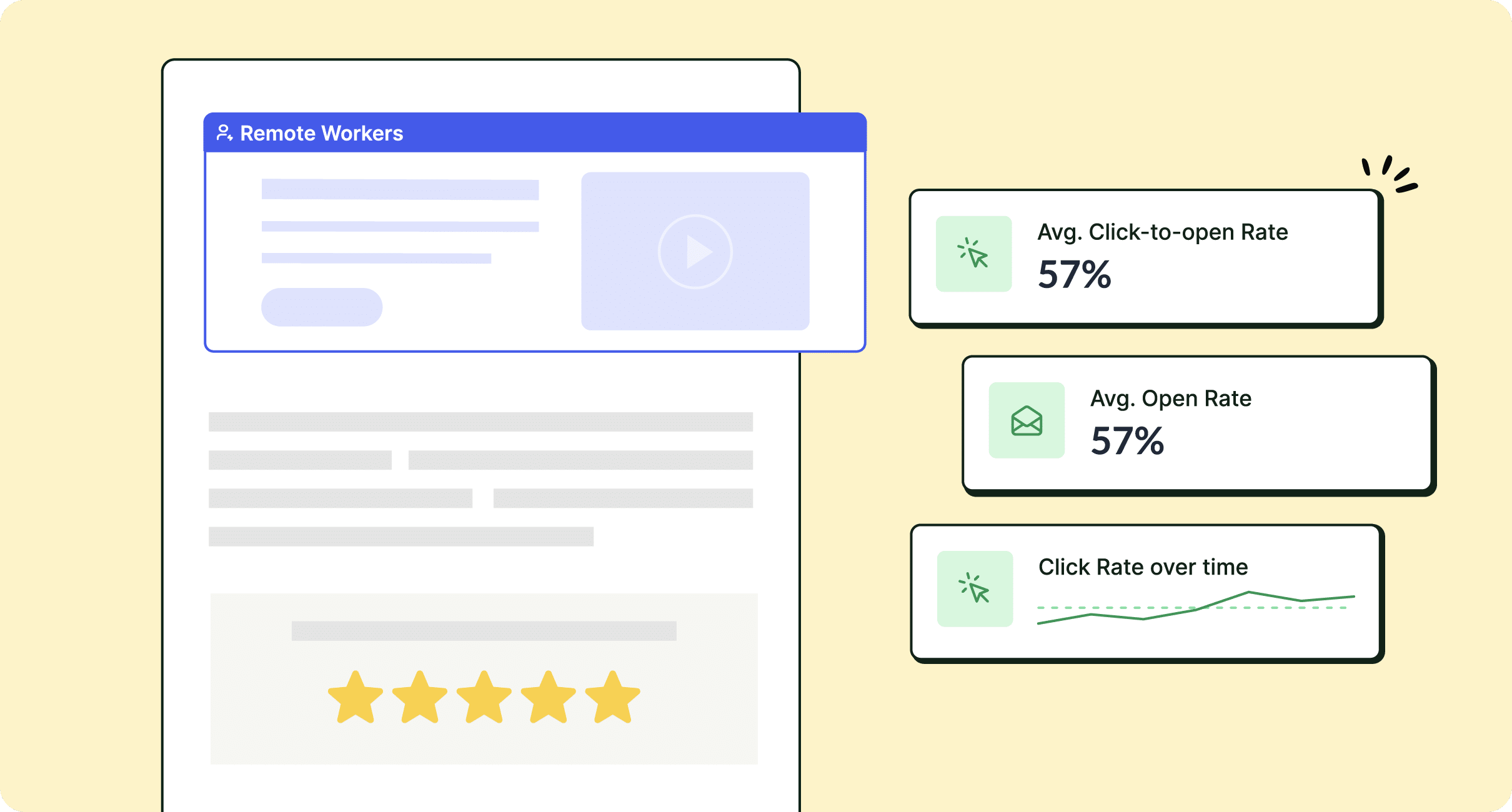Remote work isn’t a novelty. A distributed workforce is a modern workforce. In this guide, we’ll explore 15 ways to boost remote employee engagement with email.
As remote work continues to trend upward, internal communicators must find new ways to engage their team regardless of location. There are legitimate remote team communication challenges that differ from in-office challenges.
However, with the right approach, you can leverage remote staff engagement with email to build a strong culture, keep employees informed, and encourage collaboration—even at a distance.
This post will show you how to keep remote staff engaged using email with 15 proven tactics to keep your company culture thriving.
Take a self-guided tour of ContactMonkey
See how our key features can streamline your internal communications.
Take product tour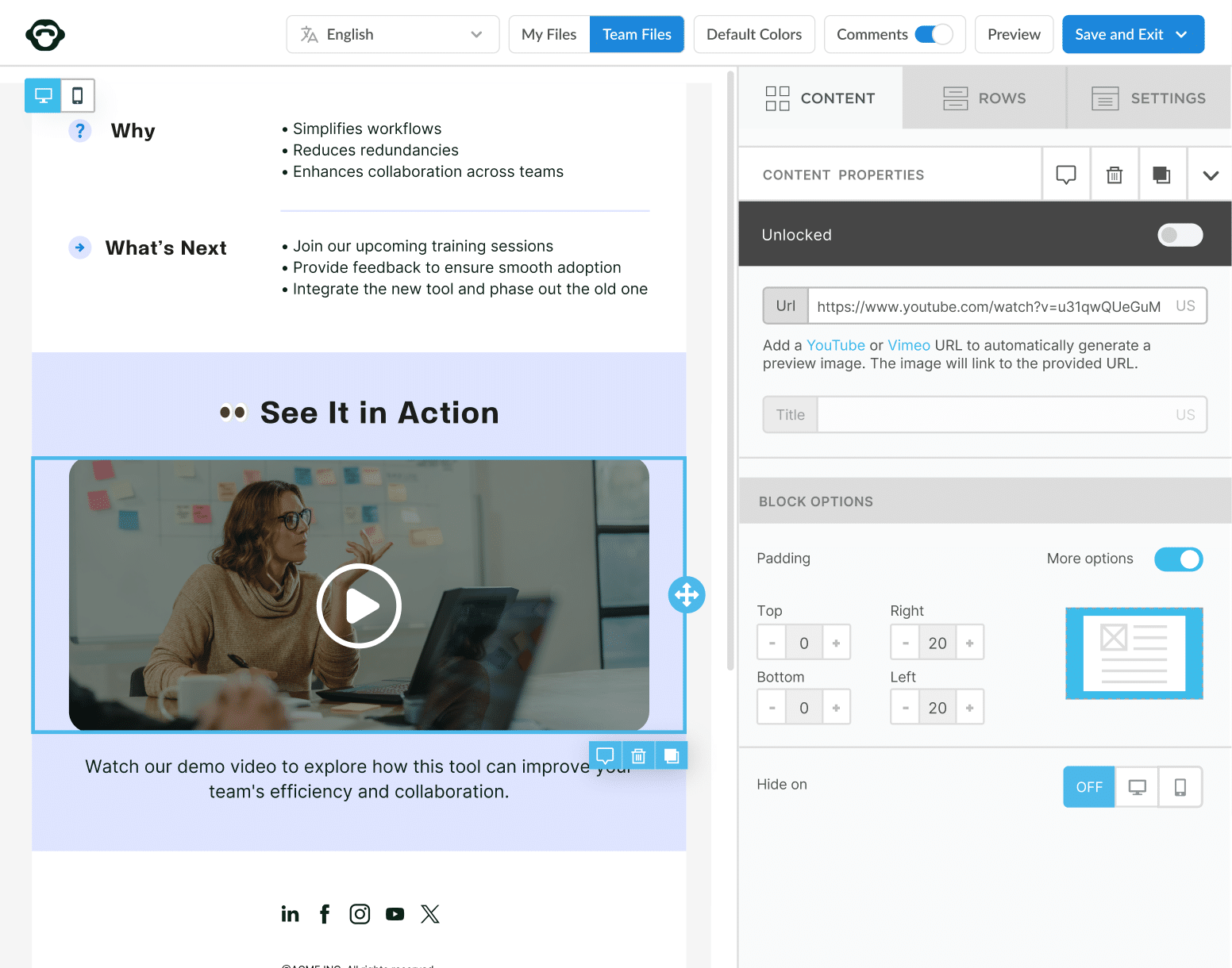

Why is it Important to Keep Your Remote Employees Engaged?
Consistent communication through your remote staff’s engagement with email unifies teams around shared goals and values. Here are five key reasons why remote employee engagement using email is mission-critical:
- Reduces isolation: By understanding how to keep remote employees engaged with email, you ensure that physically distant workers still feel recognized and connected to the broader organization.
- Boosts productivity: Focusing on remote employee engagement with email helps align everyone with core objectives, raising efficiency and accountability.
- Improves retention: Engaging remote staff with email fosters loyalty and lowers turnover by making employees feel valued and supported.
- Reinforces culture: Learning how to engage remote staff with email allows you to highlight company values and maintain a cohesive ethos—even from afar.
- Inspires innovation: Mastering how to manage remote employee engagement with email encourages open communication, sparks fresh ideas, and drives continuous growth across the organization.
Why Use Email to Engage Remote Employees?
Regardless of location, time zone, or schedule, employees can receive emails and respond to action items. Here are a few reasons why email for remote employees remains a communications cornerstone:
- Universally accessible: Asynchronous delivery means everyone—from night owls to early risers—can stay informed without missing a beat.
- Centralized communication: Email’s structured format keeps important details organized and easy to reference, supporting how to keep remote employees engaged with email in a clear, consistent manner.
- Scalable and automated: Automated workflows let you manage frequent updates, saving time and helping you master how to engage remote staff with email at scale.
- Measurable impact: Email analytics track open rates, click-throughs, and replies, offering insights on how to manage remote employee engagement with email and refine your communications strategy.
Benefits of Modern Internal Email Platforms
Modern remote team communication tools go far beyond the capabilities of basic email clients, providing analytics, personalization, and real-time feedback loops. These innovations deliver better results compared to traditional email methods and help you execute your remote communications.
- Advanced analytics: Track open rates, click-throughs, and engagement in real-time.
- Personalization at scale: Segment and tailor content by role or department to deliver relevant messages.
- Built-in feedback tools: Use polls, surveys, and reaction emojis to measure sentiment and gather input.
Start two-way conversations and employee feedback loops
Learn how to engage staff with pulse surveys, content ratings and reactions, custom polls, and more. Ready to send modern emails?
See engagement features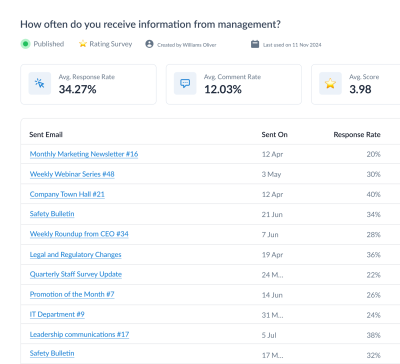
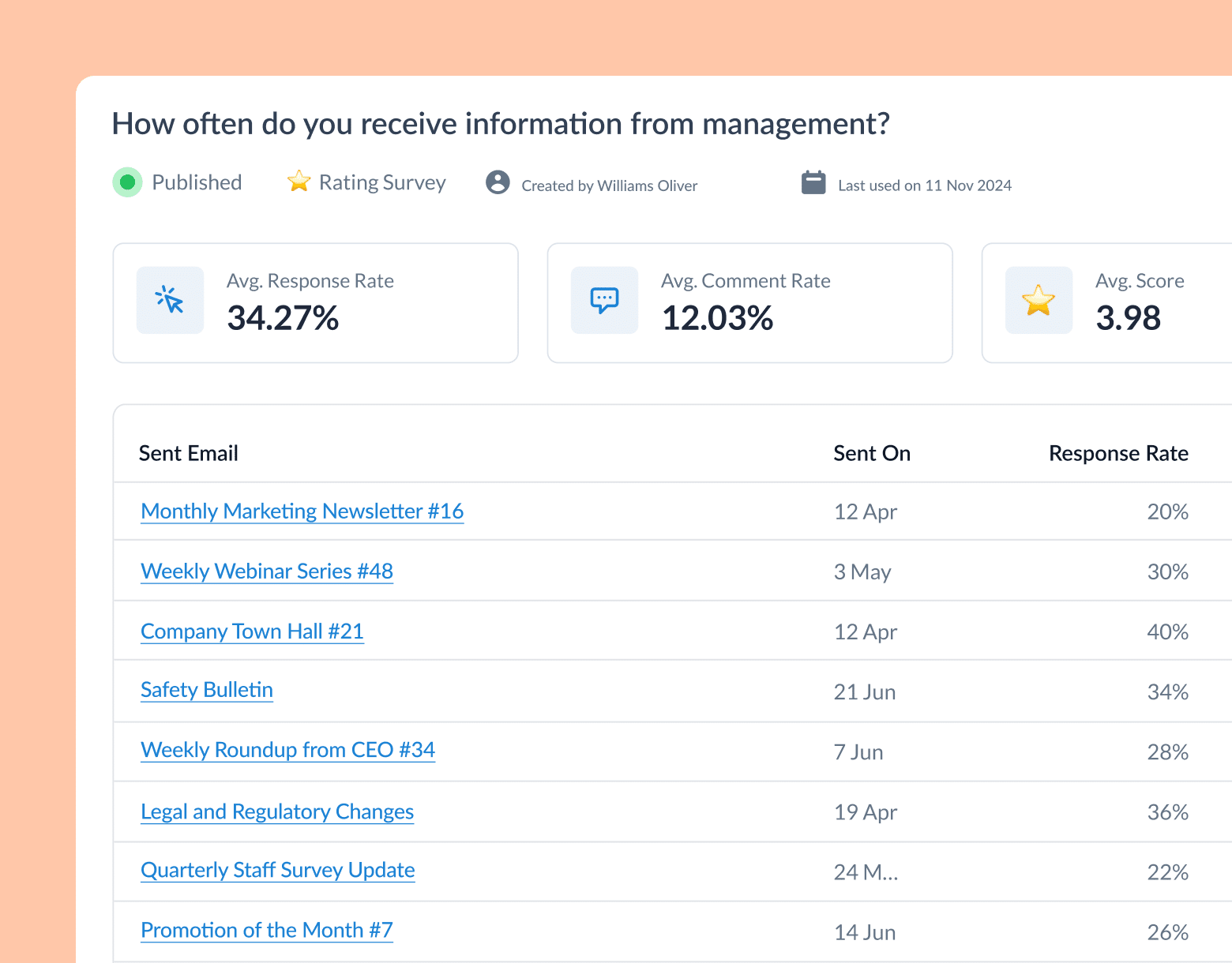
How to Engage Remote Employees with Internal Email
Below, we’ll explore proven strategies for keeping your remote teams connected, motivated, and aligned—no matter where they’re located—to help support your distributed workforce.
1. Segment and personalize your communications
Tailor your internal emails based on role, department, or even personal interests. This approach makes each message more relevant for remote employee engagement with email and prevents remote team communications from feeling generic.
Why this is important for remote staff engagement with email: Personalized messages resonate more strongly, ensuring that each remote worker only receives content that directly impacts them.
Benefits of this tactic: Higher open rates, less message fatigue, and a greater sense of inclusion among dispersed teams.
Actionable examples:
- Create separate mailing lists for managers, new hires, and specific project teams.
- Offer customized newsletters featuring role-specific tips or departmental updates.
PRO TIP
With ContactMonkey’s segmentation features you can filter and target employees by department or location. This makes engaging remote staff with email a breeze!
2. Use interactive polls, surveys, and reactions
Incorporate polls, surveys, and reaction emojis to foster two-way communication. These tools bring remote employee engagement to life by capturing real-time feedback and sentiment.
Why this is important for remote staff engagement with email: Remote employees often feel isolated and crave avenues to be heard. Interactive elements encourage immediate participation.
Benefits of this tactic: Rapid insights into morale, more engaged readership, and a sense of inclusion for employees who can’t offer feedback in person.
Actionable examples:
- End each newsletter with a one-click poll on team satisfaction.
- Add emojis to your weekly digest, letting employees react to announcements.
How to use ContactMonkey: Built-in employee feedback features in ContactMonkey streamline how to manage remote employee engagement with email, giving you quick data on what resonates most.
Build engaging, interactive employee emails in minutes
Build amazing emails quickly and easily using our drag-and-drop template builder. No design or technical expertise needed.
Explore email builder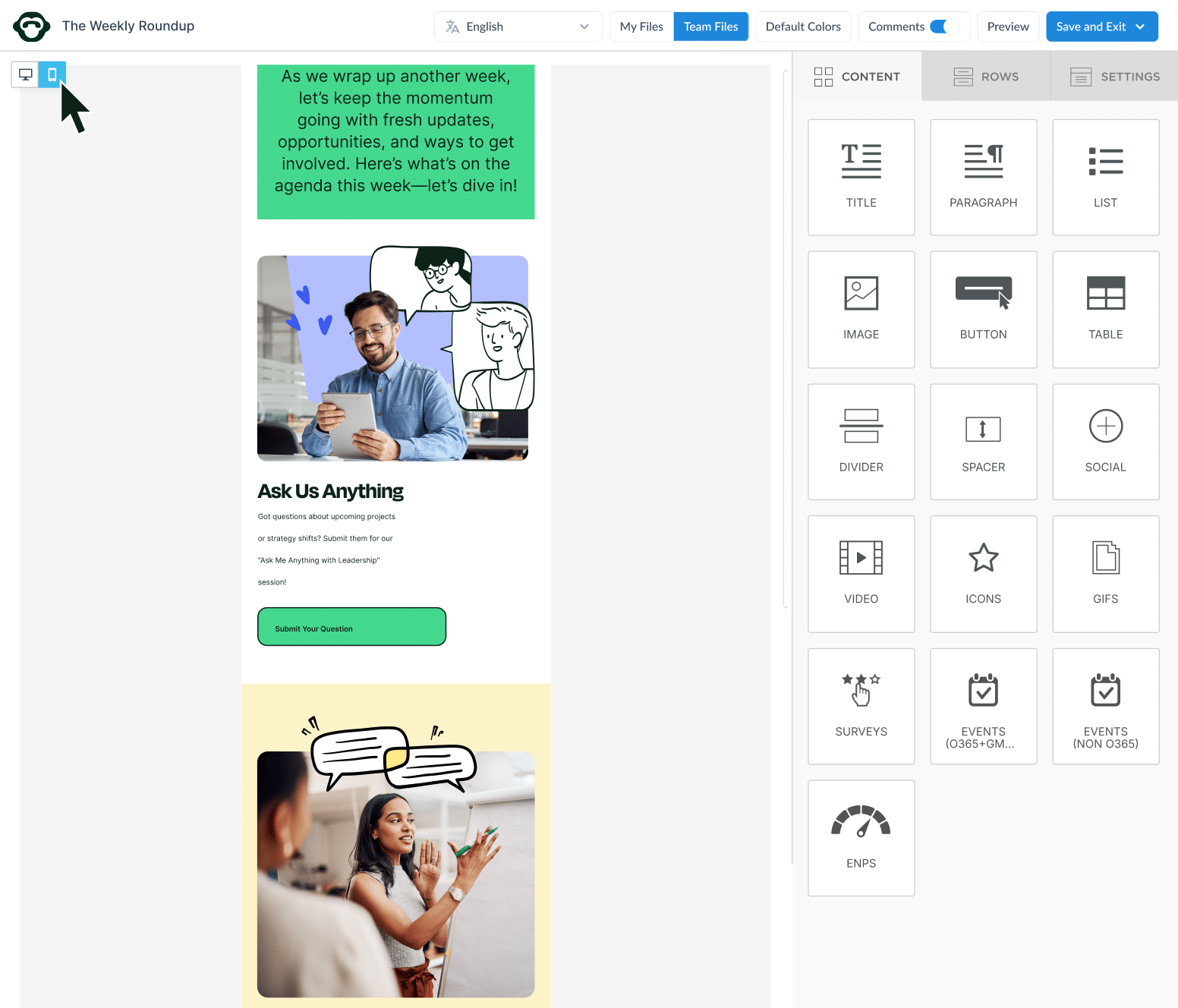
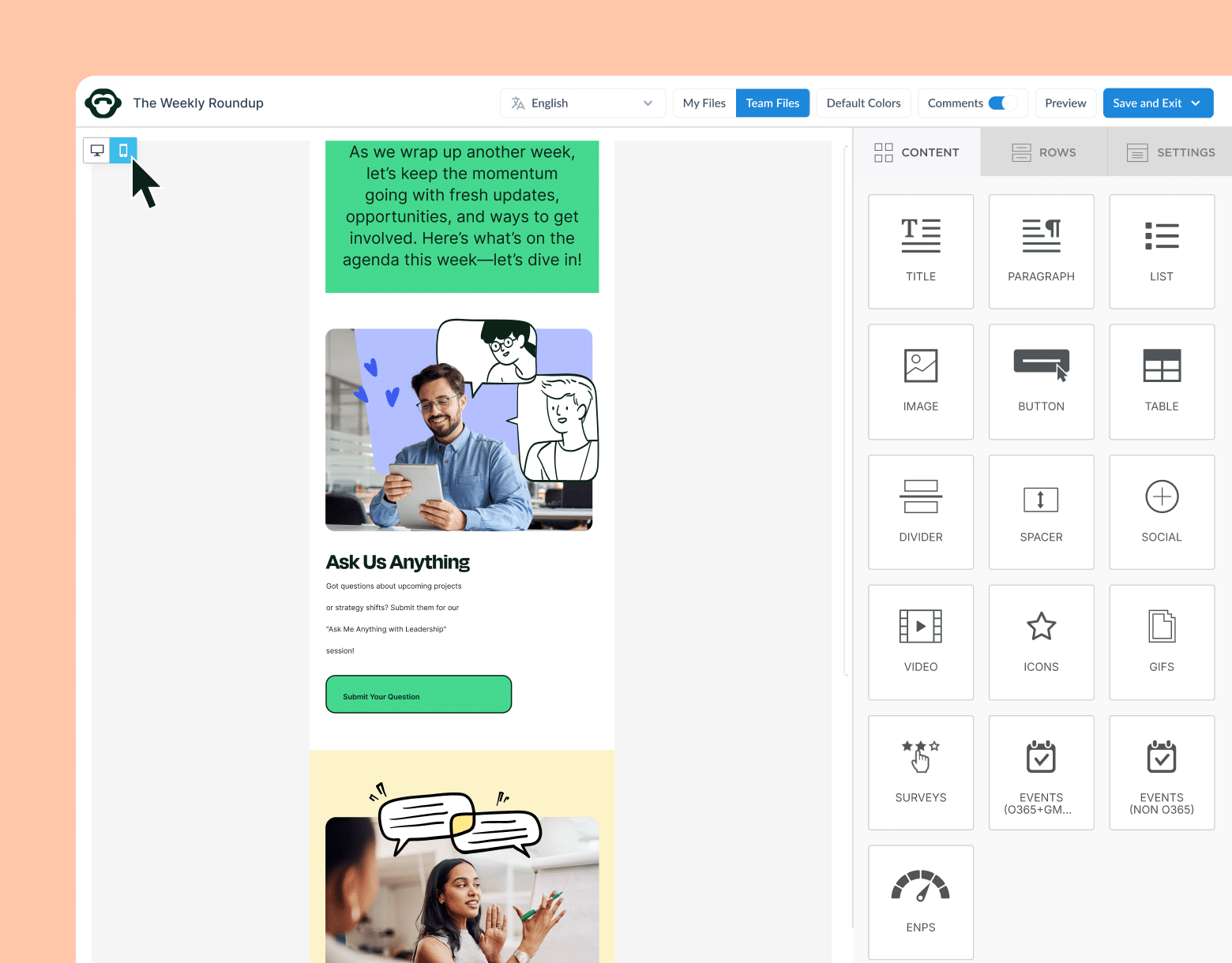
3. Recognize successes and milestones
Publicly celebrate big or small wins via internal email. This strategy for engaging remote staff with email fosters a culture of appreciation that reaches employees wherever they are.
Why this is important for remote staff engagement with email: Recognition motivates remote employees who might otherwise feel their efforts go unseen.
Benefits of this tactic: Boosted morale, stronger team spirit, and positive reinforcement that aligns with your company’s core values.
Actionable examples:
- Dedicate a monthly “Remote Star” newsletter section to highlight individual accomplishments.
- Send a quick kudos email to recognize team achievements, like finishing a major project on time.
PRO TIP
Pre-built template features in the ContactMonkey platform let you seamlessly design recognition emails, ensuring that keeping remote staff engaged with email remains both eye-catching and efficient
4. Deliver consistent newsletter updates
Establish a regular cadence of newsletters to share important company news, policy changes, and upcoming events.
Why this is important for remote staff engagement with email: Predictable updates build trust and help remote employees stay on top of everything from deadlines to cultural employee engagement initiatives.
Benefits of this tactic: Reduced confusion, transparent leadership, and unified awareness of organizational goals.
Actionable examples:
- Launch a weekly “Kickoff Digest” each Monday to outline key priorities.
- Summarize team wins in a Friday round-up, keeping employees informed before the weekend.
5. Highlight professional development opportunities
Provide access to eLearning modules, webinars, and training events. Including these in your remote employee engagement using email strategy underscores your commitment to continual learning.
Why this is important for remote staff engagement with email: Remote employees want clear pathways for skill enhancement, just like on-site teams.
Benefits of this tactic: Higher retention, stronger employee loyalty, and a more knowledgeable workforce capable of driving innovation.
Actionable examples:
- Feature a “Skill-Building Spotlight” in your monthly newsletter with upcoming courses.
- Send invitation emails for department-specific training sessions with direct sign-up links.
PRO TIP
ContactMonkey’s link tracking lets you see which resources resonate most, and helps you support your employees’ professional growth.
6. Encourage peer-to-peer contributions
Invite employees themselves to contribute content, updates, or tips. This organic approach to employee engagement for remote employees builds community from within.
Why this is important for remote staff engagement with email: Content written by peers resonates more strongly than top-down announcements, reinforcing a sense of camaraderie.
Benefits of this tactic: Authentic dialogue, increased knowledge sharing, and a greater feeling of ownership among remote workers.
Actionable examples:
Modern internal comms and measurement tools
No design or technical expertise needed. Save time, increase engagement, and dazzle your employees with fun and interactive communications.
Explore all features

- Feature a “Department Spotlight” each month, where a different team showcases current projects.
- Let employees write short pieces about work-life balance or remote hacks.
7. Maintain transparency through company-wide updates
Share policy changes, financial results, and leadership decisions openly. This transparent approach is key to engaging remote staff with email in a way that fosters trust.
Why this is important for remote staff engagement with email: Clear, timely updates reduce uncertainty and suspicion, especially when teams can’t gather in a single office.
Benefits of this tactic: Greater alignment with company goals, stronger mutual respect, and a more informed, confident workforce.
Actionable examples:
- Send quarterly “State of the Company” emails with concise overviews of financial and operational milestones.
- Include Q&A sections where leadership directly addresses top employee concerns.
8. Promote well-being and work-life balance
Actively support mental health and healthy work habits via remote employee engagement with email initiatives. Remote workers often juggle different time zones and personal commitments.
Why this is important for remote staff engagement with email: Showing genuine concern for employees’ well-being fosters loyalty and prevents burnout.
Benefits of this tactic: Improved morale, lower turnover, and a supportive community that values mental health.
Actionable examples:
- Dedicate a newsletter section to “Wellness Tips” like desk exercises or mindfulness practices.
- Share links to upcoming virtual fitness classes or mental health workshops.
🎁 BONUS
Don’t forget to remind your employees of their health and well-being supports! Leverage our guide on employee benefits communication for more on this front.
9. Celebrate social connection through team-building challenges
Spark friendly competition with virtual events like quizzes, step challenges, or theme-based contests. These are classic employee engagement activities for remote employees that encourage camaraderie.
Why this is important for remote staff engagement with email: Remote employees often miss casual office interactions; team-building events replicate those water-cooler moments digitally.
Benefits of this tactic: Strengthened relationships, increased engagement, and a fun, dynamic culture that carries across locations.
Actionable examples:
- Host a monthly “Remote Trivia Night” and email clues beforehand.
- Create a shared photo contest (e.g., best home office setup) and reveal the winner in your next newsletter.
Take a self-guided tour of ContactMonkey
See how our key features can streamline your internal communications.
Take product tour

10. Solicit—and act on—employee feedback
Request regular input through surveys or open-ended questions, then implement changes based on the responses. This is crucial for how to manage remote employee engagement with email in a continuous improvement loop.
Why this is important for remote staff engagement with email: Employees who feel heard are more likely to stay motivated and aligned with company goals.
Benefits of this tactic: Better organizational decisions, stronger trust in leadership, and a more engaged remote workforce.
Actionable examples:
- Send quarterly “Pulse Surveys” to measure satisfaction and gather suggestions.
- Follow up in your next email with survey highlights and clear action steps.
11. Leverage visual content and multimedia
Enhance your internal emails by incorporating images, videos, and infographics. This enriches your communications and makes remote employee engagement with email more dynamic and visually appealing.
Why this is important for remote staff engagement with email: Visual elements capture attention quickly and improve message retention among remote workers.
Benefits of this tactic: Increased engagement, improved clarity, and a more memorable communication experience.
Actionable examples:
- Embed a short video message from leadership or create an infographic summarizing key company updates.
- Use animated GIFs to highlight upcoming events or celebrate milestones.
12. Implement automated follow-ups and reminders
Set up automated follow-ups to ensure important messages are acknowledged and acted upon. This tactic helps reinforce how to manage remote employee engagement with email by minimizing missed communications.
Why this is important for remote staff engagement with email: Automated reminders ensure that critical updates are not overlooked, keeping remote employees aligned with company priorities.
Benefits of this tactic: Consistent communication, reduced manual workload, and improved task completion rates.
Actionable examples:
- Automate onboarding check-ins, policy reminders, or event notifications through a series of follow-up emails.
- Schedule reminder emails for critical deadlines or training sessions.
Watch ContactMonkey LIVE in action
Join live demo
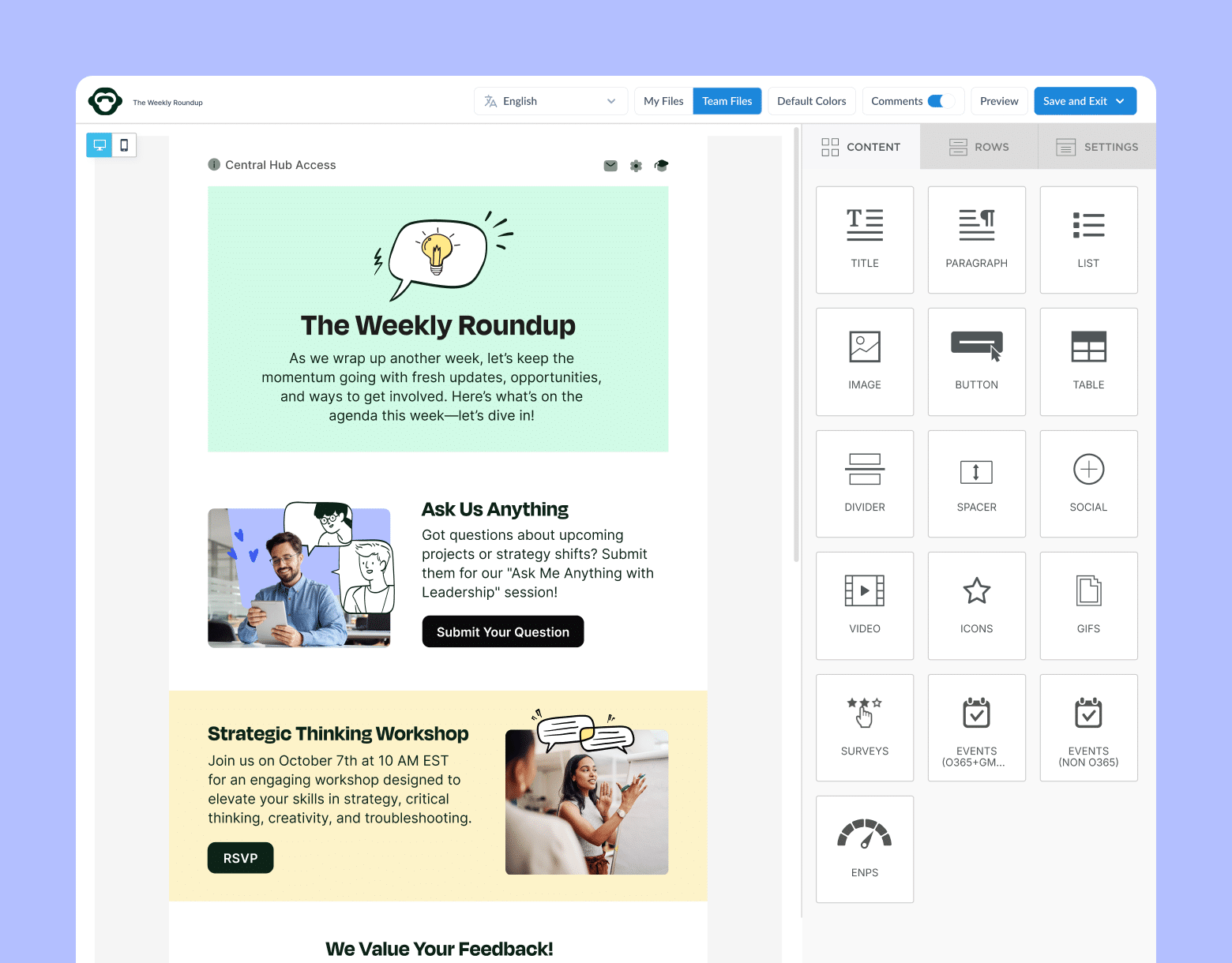
13. Host virtual town halls via email announcements
Utilize email to promote and organize virtual town halls, providing a platform for leadership to share updates and answer questions. This is key for how to engage remote staff with email by uniting the workforce around a shared vision.
Why this is important for remote staff engagement with email: Virtual town halls create a space for open dialogue, reinforcing transparency and community among remote teams.
Benefits of this tactic: Enhanced alignment with company strategy, increased trust in leadership, and a unified company culture.
Actionable examples:
- Send detailed email invitations for upcoming town halls with agendas and Q&A sections.
- Follow up with a summary email capturing key points and action items discussed.
14. Use gamification elements in emails
Introduce gamified elements like quizzes, challenges, or reward systems in your internal communications. Gamification transforms routine emails into engaging activities that promote remote employee engagement with email.
Why this is important for remote staff engagement with email: Gamification makes interactions fun and can boost participation, especially among remote employees who may miss in-person activities.
Benefits of this tactic: Increased interactivity, higher engagement rates, and a more dynamic and enjoyable work culture.
Actionable examples:
- Embed a weekly quiz with small incentives or digital badges for correct answers.
- Organize monthly challenges where employees compete for recognition in the next newsletter.

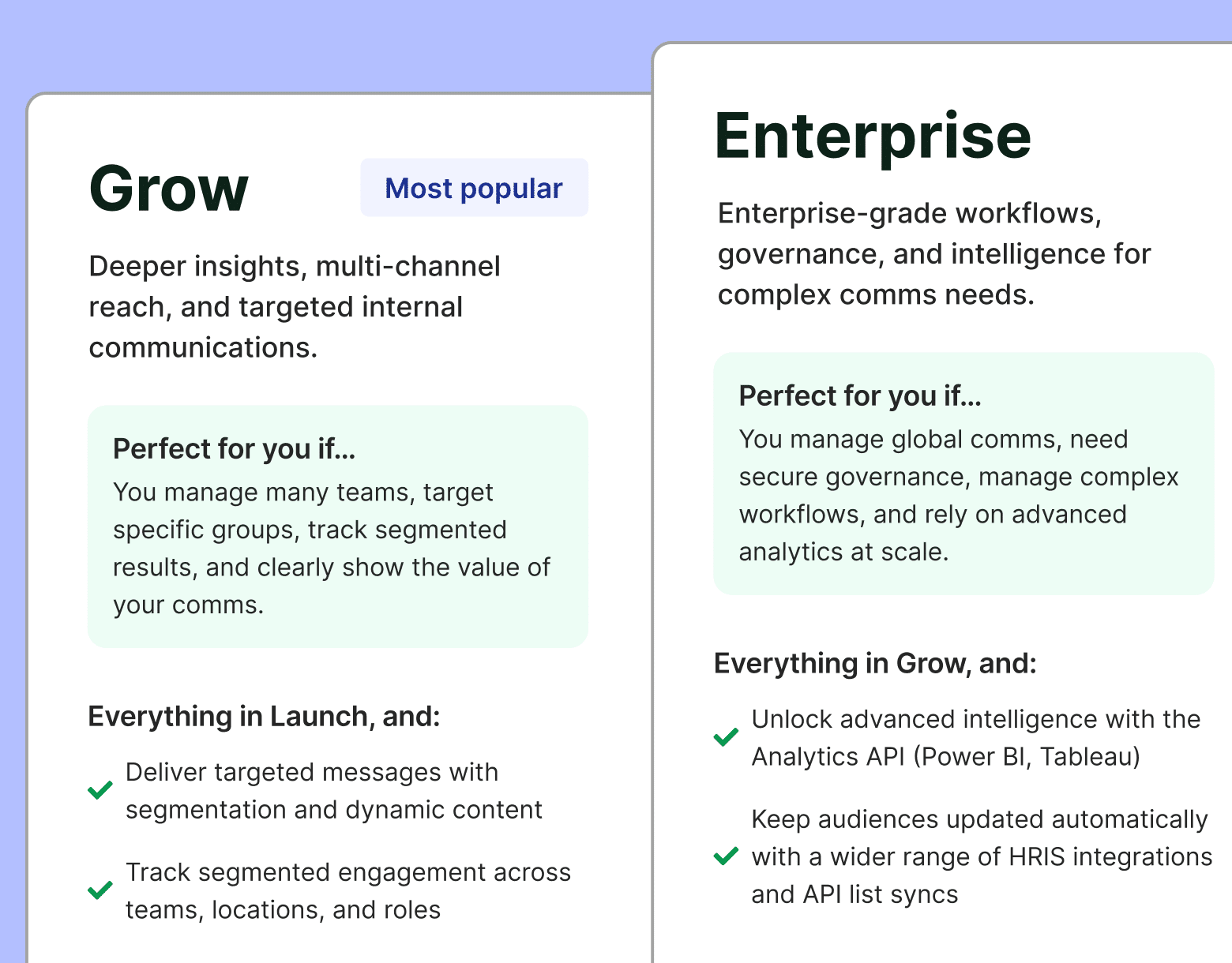
15. Integrate with collaboration tools and calendar invites
Seamlessly connect your internal email communications with collaboration platforms and calendar apps to streamline work processes. This integration is vital for how to engage remote staff with email by reducing friction between communication and action.
Why this is important for remote staff engagement with email: Integration ensures that employees can easily transition from reading an email to joining a meeting or accessing shared documents, boosting overall productivity.
Benefits of this tactic: Enhanced productivity, improved meeting attendance, and smoother workflows for remote teams.
Actionable examples:
- Include direct calendar invites in your emails for upcoming virtual meetings or training sessions.
- Add links to collaboration platforms like Slack or Microsoft Teams to facilitate immediate engagement.
Key Reasons to Use ContactMonkey for Remote Employee Engagement
ContactMonkey is a dedicated internal email solution that streamlines remote employee engagement with email through data-driven insights and user-friendly features. Here are a few reasons why ContactMonkey stands out as a must-have internal comms tool:
- Advanced analytics: Track open rates, click-throughs, and read times in real-time through our advanced analytics dashboard feature.
- Easy personalization and segmentation: Tailor your internal emails to different roles, departments, or time zones—an essential step in how to keep remote employee engaged with email.
- Built-in feedback tools: Incorporate polls, surveys, and emoji reactions right into your emails. This two-way communication is at the heart of how to engage remote staff with email, offering immediate insight into employee sentiment and enhancing remote staff engagement with email.
- Seamless integrations: Take advantage of user-friendly templates while connecting to your existing Outlook or Gmail with a simple integration.
- Automated scheduling and workflows: Set up recurring newsletters or onboarding campaigns to maintain a steady flow of information—a cornerstone of keeping remote staff engaged with email over time.
Ready to see how to manage remote employee engagement with email more effectively? Book your free demo of ContactMonkey today!



